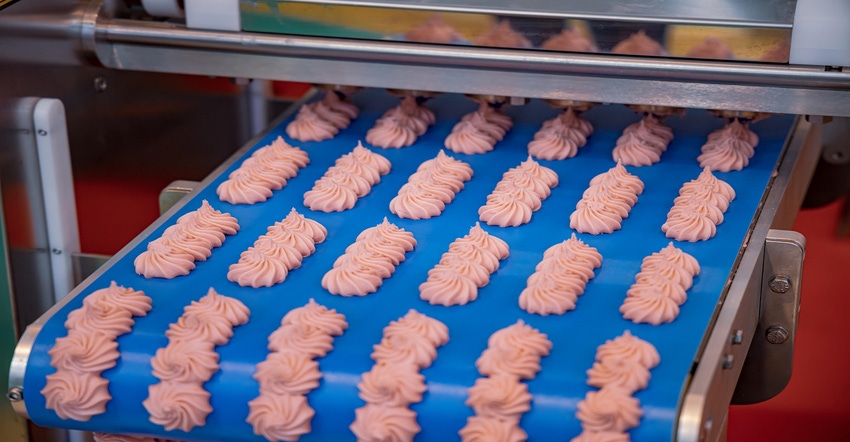AI can quickly change the way activities or tasks are performed in food manufacturing. AI can help companies rapidly adapt while providing a tangible return on investment.
July 22, 2022

Ian Hart, business development director, adi Projects
Automation technology has been on a path of steady growth for years. Having been one of the top industry trends in 2022 based on extensive data evidencing its increasing importance in the food sector, it is safe to assume that these newfound solutions are here to stay, and for a reason.
The future of manufacturing revolves around Industry 4.0, and AI is an intrinsic part of how product distribution practices are morphing to make room for machine learning and smart solutions. With this new era fast approaching, it is critical that manufacturers turn to automation and AI to deal with emerging trends within the food and beverage industry.
The Post-Pandemic World
The Covid-19 pandemic has accelerated the rise of new digital technologies, and as we emerge from the earlier, more challenging stages of the pandemic, we are faced with a world that relies even more extensively on automation.
During the pandemic, companies had to devise ways of coping with staff shortages and unstable work conditions, with safety regulations also affecting the amount of personnel that was able to be in a facility at any given time. In an era when relying on manual labor has become increasingly more difficult, food manufacturers find themselves in need of modern solutions, which automation technology and AI can offer.
By investing in systems capable of carrying out tasks and processes consistently and efficiently, manufacturers can rely on processes that are significantly more risk-free while also complying with new, fast-changing regulations and addressing Covid-related concerns such as sanitation.
Considering Food Safety
The Covid-19 pandemic has undoubtedly changed the way individuals think about hygiene, prompting them to consider how and where their food is produced and packaged. This wave of concern regarding food hygiene was fast-rising regardless of the lack of evidence that the virus could be transmitted through food, rendering new solutions capable of catering to these needs essential.
Automated procedures can significantly reduce the risk of food-safety hazards, putting consumers’ minds at ease. Ultimately, we should aim to shift our focus to what’s going to benefit consumers long-term – and therefore provide a return - as food hygiene concerns are unlikely to disappear any time soon.
Improving product quality should be the main point of focus for manufacturers, and a significant contributing factor to food safety and compliance is cleaning practices. Traditional cleaning procedures cannot compete with intelligent systems capable of detecting even the smallest of toxins or contaminants, drastically improving product quality as a result.
The procedure of cleaning equipment can also be optimized by employing AI, which can be programmed to detect even the smallest of substances that could potentially be harmful to food production lines.
Adapting to Key Trends in the Food Industry
While the increase in production of plant-based food is not a new trend, it is nonetheless on the rise, with demand having more than doubled in value since 2016. Producing plant-based foods requires different procedures to be implemented, particularly when they are produced in the same factory as meat products. By offering efficient and quick quality assurance procedures, automation can cut down on the time that is spent ensuring there is no cross-contamination.
And this is not the only issue at the forefront of consumers’ minds. Consumers’ commitment to sustainability remains strong despite the spike in popularity of packaged food throughout the Covid-19 pandemic, with environment-conscious shoppers now returning to their pre-pandemic habits.
In this context, raising concerns about food wastage has become relevant again, and AI may just hold the key to developing stable processes to contribute to the sustainability cause. As well as being programmed to reduce waste and therefore prevent edible food from being disposed of by accident, AI technology can also be employed to collect useful data and in turn, develop algorithms that can consistently prevent waste within a supply chain.
New heights in Automated Production
Automation technology can improve the efficiency of overall manufacturing projects in a variety of ways, and open a world of previously inaccessible solutions. As it is paving the way for new routes within the food and beverage industry and beyond, it is not surprising that artificial intelligence is deemed to be the future.
Automated software can provide traceability within the supply chain by collecting and storing data that can be accessed later on by manufacturers to find faults in a system or procedure or identify the source of issues or time delays. Additionally, AI can operate in environments that could be unfit for humans, such as extremely hot or cold environments, and even contribute to producing food of higher quality by identifying ideal growing conditions for fresh produce, resulting in better flavor, and thus better products.
Implementing automated procedures to keep up with demand and changing habits is increasingly more relevant in an era where improving food reliability is essential. And while changing our habits on such short notice Is not without its challenges, AI can be programmed to quickly change the way activities or tasks are performed, ultimately providing a great return on investment by allowing manufacturers to rapidly adapt.
Manufacturers and businesses must seek expert advice to help safely manage operations that incorporate automation technology and AI.
Ian Hart is the business development director at adi Project, a division of the engineering firm adi Group. The group has experience providing tailored engineering solutions designed to efficiently address clients’ needs, no matter how complex or ambitious, while also preparing them for the future.
You May Also Like



